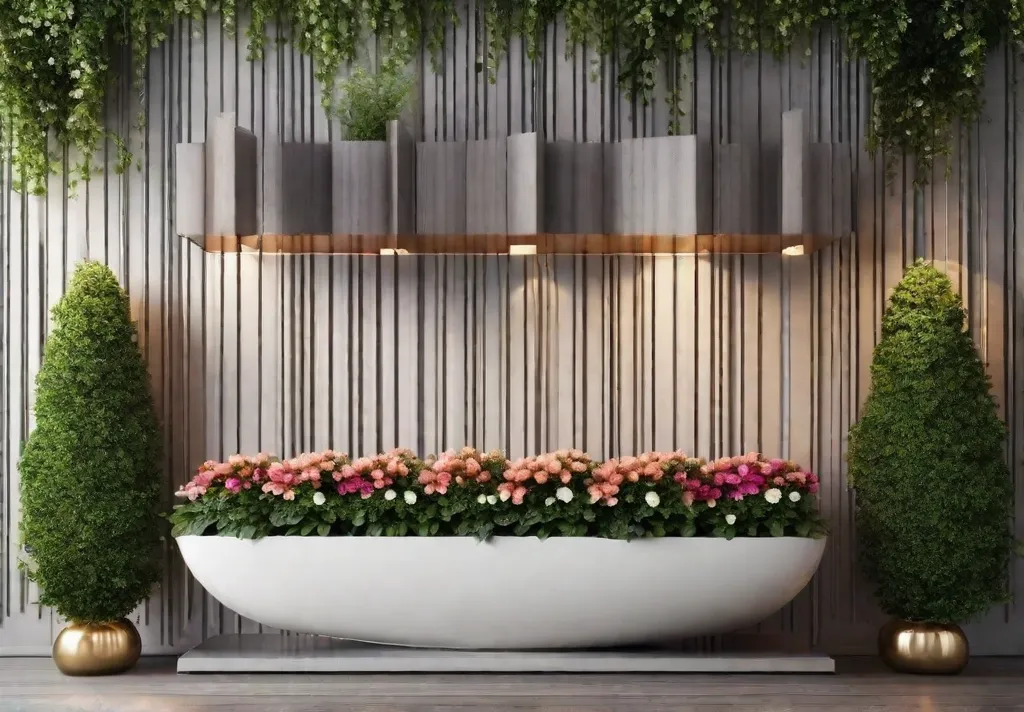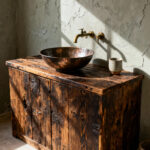Have you ever wandered through a vibrant flower garden, mesmerized by the kaleidoscope of colors and intoxicating fragrances? Flower gardens possess an enchanting power to transform even the humblest outdoor space into a captivating oasis. Whether you have a sprawling backyard or a cozy balcony, a flower garden design can cater to your unique style and space.
In this article, we’ll explore 12 breathtaking flower garden designs. From the whimsical charm of a cottage garden to the serene tranquility of a Japanese Zen retreat, you’ll discover a world of possibilities. So, let’s dive in and explore the endless beauty that awaits in flower gardens!
Small Space Solutions
Limited space is no obstacle to creating a stunning flower garden. Vertical gardening, container gardening, and hanging baskets offer innovative solutions for maximizing even the most minor areas.

Vertical gardening allows you to grow climbing plants like clematis and morning glories and climbing roses on trellises, arbors, and walls. This space-efficient technique adds height and visual interest to your garden.
Container gardening is perfect for patios, balconies, or windowsills. Choose containers of various sizes and shapes to accommodate a vibrant array of flowers. Consider self-watering containers for hassle-free maintenance.
Hanging baskets are a whimsical way to create aerial flower displays. Suspend them from ceilings, balconies, or walls, and let trailing plants like petunias, lobelia, and nasturtiums cascade down in a riot of color.
When selecting plants for small spaces, annuals like petunias, marigolds, and zinnias offer instant gratification. Perennials like daylilies, hostas, and ferns provide long-lasting beauty. Bulbs like tulips, daffodils, and crocuses add early spring blooms. Additionally, succulents like echeveria, sedum, and aloe are low-maintenance options.
The Cottage Garden
Imagine entering a charming, densely planted space bursting with color and texture. Welcome to the enchanting world of cottage gardens! These gardens feature a delightful mix of flowers, herbs, and vegetables, creating a whimsical and inviting atmosphere.
Traditional cottage garden favorites include roses, lavender, foxgloves, hollyhocks, and delphiniums. Gravel paths and picket fences add a touch of rustic charm, while trellises and arbors support climbing plants.

Originating in the English countryside during the 17th century, cottage gardens were grown by villagers for both beauty and sustenance. Modern adaptations incorporate sustainable practices like organic gardening and native plants while maintaining the traditional charm.
Companion planting, where flowers, herbs, and vegetables are grouped for mutual benefits, is a critical element of cottage gardens. Creating a haven for pollinators like butterflies and bees enhances the garden’s biodiversity.
The Formal Garden
Exuding elegance and symmetry, formal gardens are a testament to meticulous design. These gardens feature neatly arranged flower beds, trimmed hedges, and sculpted topiaries, creating a sense of order and grandeur.
Hedges define the garden’s boundaries, often trimmed into geometric shapes like rectangles or circles. Topiaries, trees, or shrubs shaped into decorative forms add a touch of whimsy and sophistication.

Color coordination is crucial in formal gardens, with flower beds carefully planned to create harmonious and visually appealing displays. Plant selection is equally important, ensuring year-round appeal with a succession of blooms.
Famous examples of formal gardens include the Versailles Gardens in France, the Keukenhof Gardens in the Netherlands, and the Yuyuan Garden in China. These gardens showcase the beauty and precision of formal design on a grand scale.
The Modern Minimalist Garden
The modern minimalist garden is a sanctuary of calm, embracing the principles of simplicity and serenity. Inspired by Japanese Zen gardens, this style prioritizes using space, clean lines, and a restrained color palette.
With their architectural forms and low water requirements, succulents are a perfect fit for minimalist gardens. Ornamental grasses like Japanese sedge and Miscanthus add texture and movement, while green, white, and gray shades create a serene backdrop.

Hardscaping elements like concrete, stone, and metal play a significant role in defining spaces and creating structures. Patios, walkways, walls, and fences contribute to the minimalist aesthetic, while water features like small fountains or ponds add a tranquil element.
In minimalist gardens, negative space is as vital as planted areas, creating balance and serenity. Geometric shapes like squares, rectangles, and circles are commonly used to create an ordered look, while asymmetry can add a touch of intrigue.
The Edible Flower Garden
Why settle for beauty alone when you can combine it with functionality? Edible flower gardens offer the best of both worlds, allowing you to indulge in the vibrant colors and delicate flavors of edible blooms.
With their spicy leaves and flowers, Nasturtiums add zest to salads, sandwiches, and dips. Sweet, mild-tasting pansy petals enhance desserts, salads, and tea blends. Delicate violet petals lend color and a subtle floral flavor to various dishes.

When designing an edible flower garden, consider companion planting, grouping edible flowers with compatible plants like tomatoes, basil, and carrots. Vertical gardening and edible borders are excellent ways to maximize space and showcase your edible blooms.
Embracing organic gardening practices is vital to preserving your edible flowers’ flavor and health benefits. Avoid synthetic pesticides and fertilizers and instead focus on nurturing soil health and promoting biodiversity.
The Wildlife-Friendly Garden
Design a garden that attracts and supports a variety of species to transform your outdoor space into a haven for local wildlife. Native plants are:
- The cornerstone of a wildlife-friendly garden.
- Providing food and shelter for birds, bees, and butterflies.
- Other creatures.
Choose native plants that bloom throughout the year, offering a continuous food source. Sunflowers, butterfly bushes, and coneflowers are excellent choices for attracting pollinators.

Incorporate water features like birdbaths or ponds to provide drinking and bathing spots for birds and other wildlife. Add brush piles, rock gardens, and birdhouses to create shelter and nesting opportunities.
Wildlife-friendly gardens support biodiversity and reduce the need for pesticides, as native plants are naturally resistant to pests. Additionally, these gardens help improve water quality by filtering pollutants and creating a sense of place by connecting homeowners to the local ecosystem.
The Tropical Paradise
Escape to an exotic retreat in your backyard with a lush, vibrant tropical garden. Bold colors, ample foliage, and the soothing sounds of water features transport you to a tropical paradise.
Tropical plants like palms, bananas, and hibiscus thrive in warm, humid environments with moist soil. Incorporate bright, eye-catching flowers and foliage to create a dramatic display.

Water features, such as ponds or fountains, add a tranquil element and attract wildlife. Architectural elements like trellises, arbors, and stone pathways provide structure and interest.
If you live in a cooler climate, choose hardy tropical plants like hibiscus and camellia that can tolerate lower temperatures. Protect with sheltered areas or cold frames, or consider indoor gardening in heated greenhouses or sunrooms.
The Zen Garden
Embrace the principles of Zen philosophy and create a peaceful, reflective garden space. Zen gardens incorporate rocks, sand, and minimal plantings to evoke tranquility, balance, simplicity, and natural beauty.
In traditional Zen gardens, gravel or sand beds are raked into patterns representing ripples in water. Carefully placed rocks of varying sizes and shapes create a sense of movement and balance, while sparse plantings of evergreen shrubs and trees provide subtle color and texture.

Modern interpretations blend traditional elements with contemporary materials and geometric shapes. Concrete or metal accents create a minimalist, industrial feel, while succulents and drought-tolerant plants offer interest and low maintenance.
Zen gardens can serve as spaces for practicing mindfulness and meditation, allowing you to find inner peace amidst the calming surroundings. Small water features like fountains or streams can further enhance the serene atmosphere.
The Seasonal Color Blast
Imagine a garden that dazzles with vibrant color and interest throughout the year. With careful planning, you can create a stunning display that evolves each season, offering a continuous feast for the senses.
Selecting plants with staggered blooming periods is critical to achieving a seasonal color blast. Incorporate a mix of annuals, perennials, and bulbs to ensure a succession of blooms from spring to fall.

Annuals like petunias, zinnias, and marigolds offer instant gratification, while perennials like daylilies and coneflowers return year after year. Bulbs like tulips and daffodils, with their cheerful blooms, herald the arrival of spring.
Vary plant heights and textures to create visual interest. Tall plants can be a backdrop, while shorter varieties add depth and drama. Regular deadheading and fertilization will encourage continuous blooming, while seasonal updates like replacing annuals and dividing perennials will maintain the garden’s vigor.
The Sustainable Garden
Embrace eco-friendly practices and materials to create a sustainable garden that delights the senses and nurtures the planet. Sustainable gardening reduces water consumption, improves soil health, and minimizes waste.
Native plants are the foundation of a sustainable garden, as they are adapted to the local climate and soil conditions, requiring minimal watering and maintenance. They also provide food and shelter for local wildlife, supporting biodiversity.
Water conservation techniques like drip irrigation, rainwater harvesting, and mulching can significantly reduce water consumption. Organic gardening methods, such as natural fertilizers and pest control, promote soil health and avoid harmful chemicals.

Incorporate recycled or sustainable materials into your garden structures, such as using reclaimed wood for raised beds or repurposing old tires as planters. This reduces waste and adds a unique, creative touch to your outdoor space.
A sustainable garden approach offers numerous long-term benefits, including reduced water consumption and pollution, improved soil health and biodiversity, cost savings on water, fertilizers, and pesticides, and a more resilient garden that can withstand environmental challenges.
Conclusion
The world of flower garden designs is a vibrant tapestry, offering endless possibilities to suit every space and style. Whether you envision a riotous symphony of colors or a serene oasis of tranquility, there’s a design that will capture your imagination and bring you years of joy and fulfillment.
As you embark on your flower garden journey, remember to consider your style, the limitations of your space, and the maintenance requirements of your chosen design. Embrace the opportunity to create a space that reflects your unique spirit and fosters a deep connection with nature.
So, which flower garden design resonates most with you? Share your thoughts and ideas in the comments below. Let’s embark on this enchanting journey and unlock the magic of breathtaking flower gardens!






